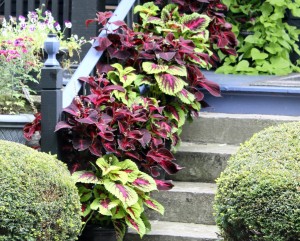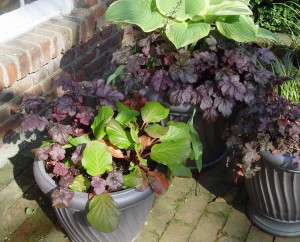Containerscaping: Take Your Potted Plants to a New Level
May 12th, 2014
A big, colorful flower pot does much to brighten any deck or patio.
That’s where most people stop – typically with the familiar pot of red geraniums surrounding a spike plant next to the door.
But as container gardening continues to outpace the annual May ritual of planting six-packs of annual flowers in the ground, one pot is no longer enough (at least not for crazed gardeners).
Clustering multiple pots is gaining steam, birthing a new gardening term called “containerscaping.”
Sometimes called “potscaping,” containerscaping is a hybrid buzzword for landscaping with container plants.
In addition to creating what are essentially “pot gardens” on decks, it includes placing them in opportune spots throughout the yard.
The idea isn’t new, but the containerscaping term seems to have originated recently with the garden-center industry, where a few enterprising places coined it to describe the service of designing and installing flower pots for customers.
It gained popularity last year when users of the social-media site Pinterest began pinning examples and sharing containerscaping tips.
Whatever you call it, interest in growing in pots has been noticeably strong for at least the past 15 years.
The main attraction has been that it offers a fairly easy way to add color to a home’s exterior without digging, weeding and battling the bunnies.
It’s certainly less labor-intensive than planting landscape beds full of annual flowers, which fewer people do anymore because of the work and expense.
Containerscaping gives an in-between option. Planting, watering and fertilizing a group or two of pots takes more effort than one big geranium pot, but it gives comparable impact to masses of in-ground flowers with significantly less work – especially the more demanding bending, digging and weeding.

This color-coordinated containerscape dresses up a back door nicely at the Hottenstein residence in Mt. Gretna.
In its kindergarten form, a containerscape can be a simple triangle of three pots. For unity’s sake, use two sizes of the same pot – two bigger ones in the back of one smaller one or one bigger one behind two smaller ones.
Another way to tie the grouping together in a “landscapey” way is by picking a plant theme color and repeating it in all three pots.
You could go with shades of red, for example, using a range of flowers from pale pink to medium pink to rose to rosy-red. Or you could use one particular plant as a unifying element in all of the pots. Purple angelonia or begonia ‘Dragon Wing,’ for example, could be the theme plant throughout with different partners in the different pots.
If you’re up for more than three pots per group, add as many as the space permits.
Keep in mind that odd numbers tend to look more natural than even numbers (five or seven pots instead of four or six), and that your layout should keep the bigger pots and plants toward the back of the prevailing view.
Most people tend to automatically plant several plants in each container because that’s “just the way you do it.”
That’s not necessarily the case when you’re containerscaping in clusters.
An elegant alternative is to go with one variety of plant in each pot, then arrange the pots so the sizes, forms and textures look good with one another.
It’s very similar to how you’d arrange blocks or masses of different plants in an in-ground garden.
One of the benefits of planting in pot clusters is that it reduces water loss – at least in the pots shielded by the outer-perimeter ones bearing the brunt of the hot, summer wind. Even better, clustering is amenable to setting up an automatic drip-irrigation system.
By connecting your water spigot to a supply line that then snakes out in various “spaghetti lines” to each pot, you’ll eliminate buckets, cans and hoses.
Add a timer, and the whole process takes care of itself. Many garden centers and numerous catalog companies supply parts and whole kits. Martin’s Produce Supplies at 627 Britton Road, Shippensburg, is one local retailer specializing in irrigation supplies, and Rainbird, Drip Works, The Drip Depot and The Drip Store and among national suppliers.
It’s not as complicated or expensive as it might seem.
Containerscapes aren’t just limited to annual flowers. Most evergreens, shrubs and even trees grow fine in pots. Just lean toward dwarf or compact varieties and give them some of your bigger pots.
Perennial flowers also do well in pots. Ones with colorful foliage – such as hosta, coralbells, foamybells and most anything variegated – are especially good choices.
You can even “mine” your existing perennial beds for divisions to use in pots.
Particularly trendy is growing herbs and vegetables in pots. Give them adequate sun, water and fertilizer, and most of these perform as well or better than in a traditional garden.
A few other possibilities:
* Out in the yard, a colorful pot or three can make interesting focal points at key spots in gardens. Elevate them on blocks to stand above the crowd.
* Set pots over bare spots in the landscape, such as where the spring bulbs died back or the cool-preferring bleeding hearts and Virginia bluebells fizzled out when summer showed up.
* Flank any doorway, arbor or entry with a pair of eye-grabbing flower pots to serve as “sentinels.”
* Erect a trellis behind a vine in a pot to let it add color to a bare wall that abuts a hard surface.
* Trouble getting plants to grow in the root competition of a big tree? Just mulch the surface and grow your underplantings in pots.
(For more ideas on gardening with containers and how to grow plants in them, check out my column on “Eight Creative Ways to Pot-Garden.”)









